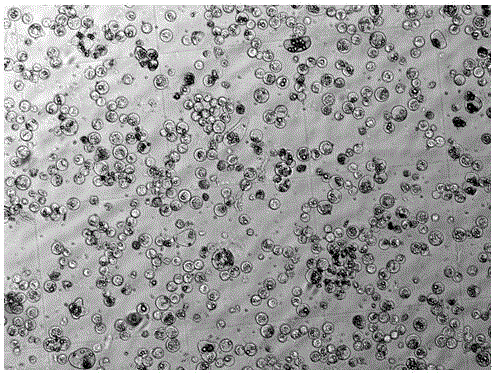Hybrid liriodendron efficient transient gene expression method using suspension cell protoplast as receptor
A technology for hybridizing Liriodendron tulipifera and protoplasts, which can be applied in the fields of biochemical equipment and methods, genetic engineering, introduction of foreign genetic material using vectors, etc., and can solve problems such as lack of research.
- Summary
- Abstract
- Description
- Claims
- Application Information
AI Technical Summary
Problems solved by technology
Method used
Image
Examples
Embodiment 1
[0038] Example 1 Plasmid preparation
[0039] The purity and concentration of the plasmid have an important impact on the transient transformation of protoplasts. The purity is low, and the conversion is difficult to succeed. If the concentration is too low, the transformation efficiency will be very low. Therefore, the purity and concentration of the plasmid is one of the key factors affecting the transformation efficiency. In this example, QIAGEN Plasmid Midi Kits were used to extract and purify the plasmid (PJIT166-GFP), which can conveniently and quickly obtain a high-purity plasmid. The specific process is:
[0040] 1) Pick a well-dispersed single colony on the plate, inoculate it in 2 mL of LB medium containing 100 mg / L ampicillin, and incubate with shaking at 37°C and 300 rpm for 8 h;
[0041] 2) Take the shaken bacterial liquid, add it to 50 mL LB medium containing 100 mg / L ampicillin at a ratio of 1:500, and culture with shaking at 37 °C and 300 rpm for 12-16 h;
...
Embodiment 2
[0055] Example 2 Separation and Purification of Hybrid Liriodendron Liriodendron Suspension Cell Protoplasts
[0056] Isolation of a large number of highly active protoplasts is the basis for the instantaneous transformation of protoplasts, and many factors such as the growth state of plant materials, the type and purity of enzymes, the time and temperature of enzymatic hydrolysis will affect the efficiency and quality of the isolated protoplasts.
[0057] In this example, using the suspension cells of Liriodendron tulipifera as materials, based on parameters such as special enzymatic hydrolysis solution, osmotic pressure, and enzymatic hydrolysis time, an effective method for preparing protoplasts of suspension cells of Liriodendron tulipifera was established. The specific steps are as follows:
[0058] 1) Preparation of enzymatic solution: Weigh 0.15 g of Cellulase R-10, 0.1 g of Macerozyme R10 and 0.01 g of PectolaseY-23 in 6.25 mL of 0.8 M mannitol, 2.5 mL of 80 mM KCl, 1 m...
Embodiment 3
[0068] Example 3 Transformation
[0069] The method for the instant transformation of protoplasts of hybrid Liriodendron chinensis suspension line cells mediated by PEI, the concrete steps are as follows:
[0070] 1) For a single reaction, add a total of 3 μg of plasmid DNA to a 2 mL centrifuge tube.
[0071] 2) Add 1 μg of PEI storage solution, add PBS until the system reaches 50 μL, mix thoroughly by ultrasonication for 2 minutes, and then let stand at room temperature for 30 minutes to prepare PEI / DNA gene carrier complex.
[0072] 3) Take 200uL of protoplasts from hybrid Liriodendron tulipifera suspension cells and mix them with PEI / DNA gene carrier complex, and gently tap with your fingers to mix the plasmid DNA and protoplast solution (or gently pipette with a wide-mouth pipette tip), Mix it well, and let it stand at room temperature for 5-10 min.
[0073] 4) Add 1mL of W5 solution and gently mix up and down to stop the transfection reaction, centrifuge at 1100rpm for ...
PUM
 Login to View More
Login to View More Abstract
Description
Claims
Application Information
 Login to View More
Login to View More - R&D
- Intellectual Property
- Life Sciences
- Materials
- Tech Scout
- Unparalleled Data Quality
- Higher Quality Content
- 60% Fewer Hallucinations
Browse by: Latest US Patents, China's latest patents, Technical Efficacy Thesaurus, Application Domain, Technology Topic, Popular Technical Reports.
© 2025 PatSnap. All rights reserved.Legal|Privacy policy|Modern Slavery Act Transparency Statement|Sitemap|About US| Contact US: help@patsnap.com


